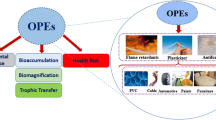Abstract
Larvae of many aquatic insects live on or in sediments and thus come into contact with contaminants which accumulate there. The larvae may bioconcentrate these contaminants in their tissues and when they emerge as adults may transport contaminants out of the aquatic system. A simple model was developed to consider the potential significance of this transport for three levels of insect production (100, 15 and 1 g m−2 yr−1) and three bioconcentration factors (10000, 1000 and 100X). The period of time it would take insects to remove 50% of contaminants from a sediment layer 30 cm thick was estimated to range from 1.2 yr for conditions of high production and a bioconcentration factor of 10000 to 12000 years for conditions of low production and a bioconcentration factor of 100. Moderate levels of production, coupled with bioconcentration factors of 10 000 and 1000, would result in removal of 50% of contaminants in 8 and 80 yr. Contaminants bioconcentrated in tissues of adult aquatic insects may enter into terrestrial food webs and could be biomagnified still further as they pass from lower to higher trophic levels. Because this evaluation was based on several assumptions and a selected set of conditions, the significance of insects in a particular situation must be determined on a case-by-case basis.
Similar content being viewed by others
References
USEPA. 1978. Mitigation feasibility for the Kepone-contaminated Hopewell/James River areas. Office of Water and Hazardous Materials, Criteria and Standards Division, Washington, D.C.
Hetling, K., Horn, E., and Tofflemire, J.: 1978, Summary of Hudson River PCB study results. Technical Paper No. 51. New York State Department of Environmental Conservation.
Diaz, R. J.: 1977, The effects of pollution on benthic communities of the tidal James River, Virginia. Ph.D. Dissertation, University of Virginia.
Lawler, Matusky and Skelly Engineers: 1975, The impact of P.L. 92-500 on the Hudson River prepared for the National Commission on Water Quality.
Shiozawa, D. K. and Barnes, J. R.: 1977,Ecology 58, 610.
Gaevskaya, N. S.: 1969,National Lending Library for Science and Technology. Boston Spa, Yorkshire, England. 533 p.
Waters, T. F.: 1977,Adv. Ecol. Research 10, 91.
Kimerle, R. A. and Anderson, N. H.: 1971,Limnol. and Oceanogr. 16, 646.
Paterson, C. G. and Walker, K. F.: 1974,Aust. J. Mar. Freshwater Res. 25, 151
Charles, W. N., East, K., Brown, D., Gray, M. C. and Murray, T. D.: 1974,Proc. Roy. Soc. Ed. (B)74, 241.
Johnson, M. G. and Brinkhurst, R. O.: 1971,J. Fish. Res. Bd. Can. 28, 1699
Menzie, C. A.: 1978, Productivity of chironomids in a littoral area of the Hudson River Estuary. Ph.D. Dissertation, The City University of New York.
Kajak, Z. and Rybak, J. L: 1970,Bull. Acad. Pol. Sci. Cl. II Ser. Sci. Biol. 18, 192.
Jonasson, P. M.: 1975,Verh. Int. Ver. Theor. Angew. Limnol. 19, 1066.
Peterson, J. L. and Hilsenhoff, W.: 1972, The role of aquatic insects in the transfer of energy and nutrients through and out of Lake Wingra. Eastern Deciduous Forest Biome Memo Report No. 72-57. IBP Program.
Mann, K. H.: 1964,Vehr. Int. Verein. Limnol. 15, 485.
USEPA.: 1976,Quality Criteria for Water (Red Book). U.S. Environmental Protection Agency, Washington, D.C.
Hall, D. J., Cooper, W. E. and Werner, E. E.: 1970,Limnol. and Oceanogr. 15, 839.
Teal, J. M.: 1957,Ecol. Mongr. 27, 283.
Nees, J. and Dugdale, R. C.: 1969,Ecology 40, 425.
Speir, J. A. and Anderson, N. H.: 1974,Limnol. and Oceanogr. 19, 154.
Environmental Protection Agency/Corps of Engineers Technical Committee on Criteria for Dredged and Fill Material: 1977, Ecological evaluation of proposed discharge of dredged material into ocean waters. Published by U.S. Army Engineer Waterways Experiment Station, Vicksburg, Mississippi.
Author information
Authors and Affiliations
Rights and permissions
About this article
Cite this article
Menzie, C.A. Potential significance of insects in the removal of contaminants from aquatic systems. Water Air Soil Pollut 13, 473–479 (1980). https://doi.org/10.1007/BF02191848
Received:
Revised:
Issue Date:
DOI: https://doi.org/10.1007/BF02191848




